2019 Hyundai Santa Fe lock
[x] Cancel search: lockPage 8 of 682
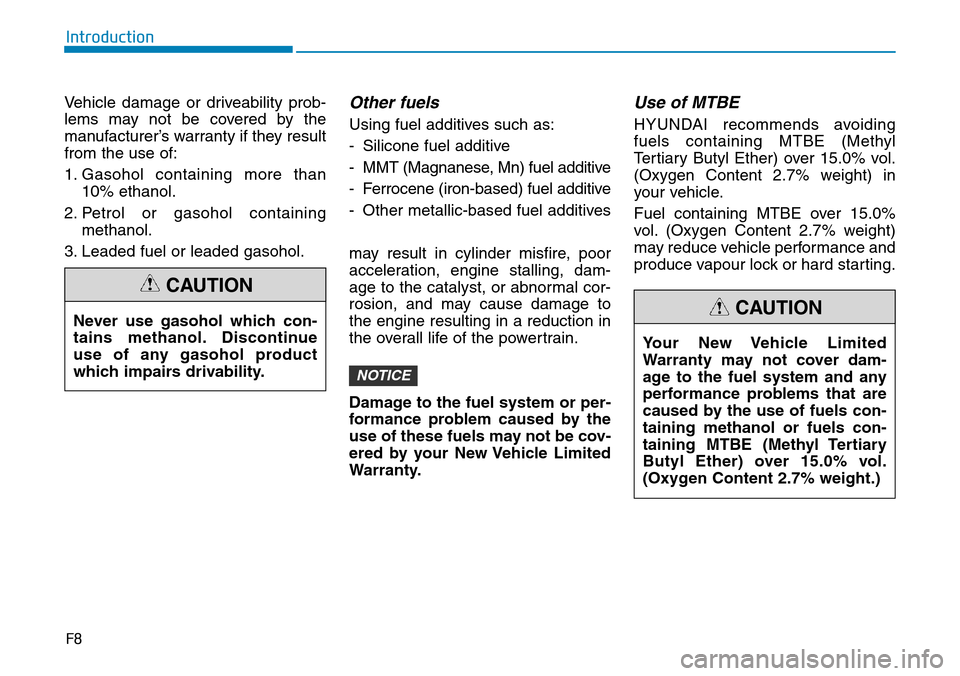
F8
Introduction
Vehicle damage or driveability prob-
lems may not be covered by the
manufacturer’s warranty if they result
from the use of:
1. Gasohol containing more than
10% ethanol.
2. Petrol or gasohol containing
methanol.
3. Leaded fuel or leaded gasohol.
Other fuels
Using fuel additives such as:
- Silicone fuel additive
- MMT (Magnanese, Mn) fuel additive
- Ferrocene (iron-based) fuel additive
- Other metallic-based fuel additives
may result in cylinder misfire, poor
acceleration, engine stalling, dam-
age to the catalyst, or abnormal cor-
rosion, and may cause damage to
the engine resulting in a reduction in
the overall life of the powertrain.
Damage to the fuel system or per-
formance problem caused by the
use of these fuels may not be cov-
ered by your New Vehicle Limited
Warranty.
Use of MTBE
HYUNDAI recommends avoiding
fuels containing MTBE (Methyl
Tertiary Butyl Ether) over 15.0% vol.
(Oxygen Content 2.7% weight) in
your vehicle.
Fuel containing MTBE over 15.0%
vol. (Oxygen Content 2.7% weight)
may reduce vehicle performance and
produce vapour lock or hard starting.
NOTICE
Your New Vehicle Limited
Warranty may not cover dam-
age to the fuel system and any
performance problems that are
caused by the use of fuels con-
taining methanol or fuels con-
taining MTBE (Methyl Tertiary
Butyl Ether) over 15.0% vol.
(Oxygen Content 2.7% weight.)
CAUTIONNever use gasohol which con-
tains methanol. Discontinue
use of any gasohol product
which impairs drivability.
CAUTION
Page 17 of 682
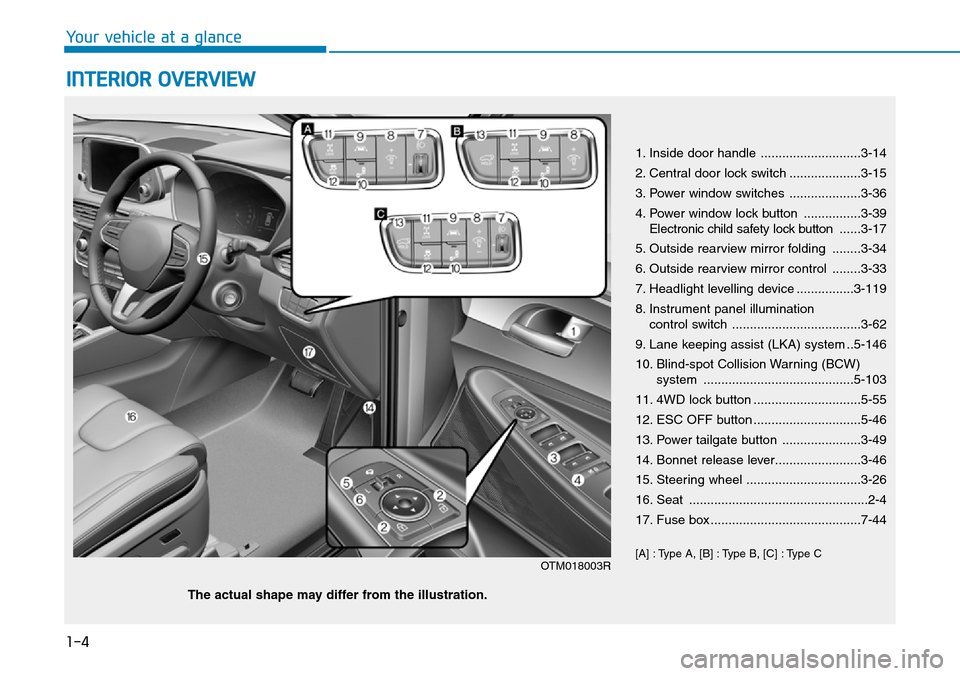
1-4
Your vehicle at a glance
INTERIOR OVERVIEW
1. Inside door handle ............................3-14
2. Central door lock switch ....................3-15
3. Power window switches ....................3-36
4. Power window lock button ................3-39
Electronic child safety lock button......3-17
5. Outside rearview mirror folding ........3-34
6. Outside rearview mirror control ........3-33
7. Headlight levelling device ................3-119
8. Instrument panel illumination
control switch ....................................3-62
9. Lane keeping assist (LKA) system ..5-146
10. Blind-spot Collision Warning (BCW)
system ..........................................5-103
11. 4WD lock button ..............................5-55
12. ESC OFF button ..............................5-46
13. Power tailgate button ......................3-49
14. Bonnet release lever........................3-46
15. Steering wheel ................................3-26
16. Seat ..................................................2-4
17. Fuse box ..........................................7-44
[A] : Type A, [B] : Type B, [C] : Type C
OTM018003R
The actual shape may differ from the illustration.
Page 26 of 682
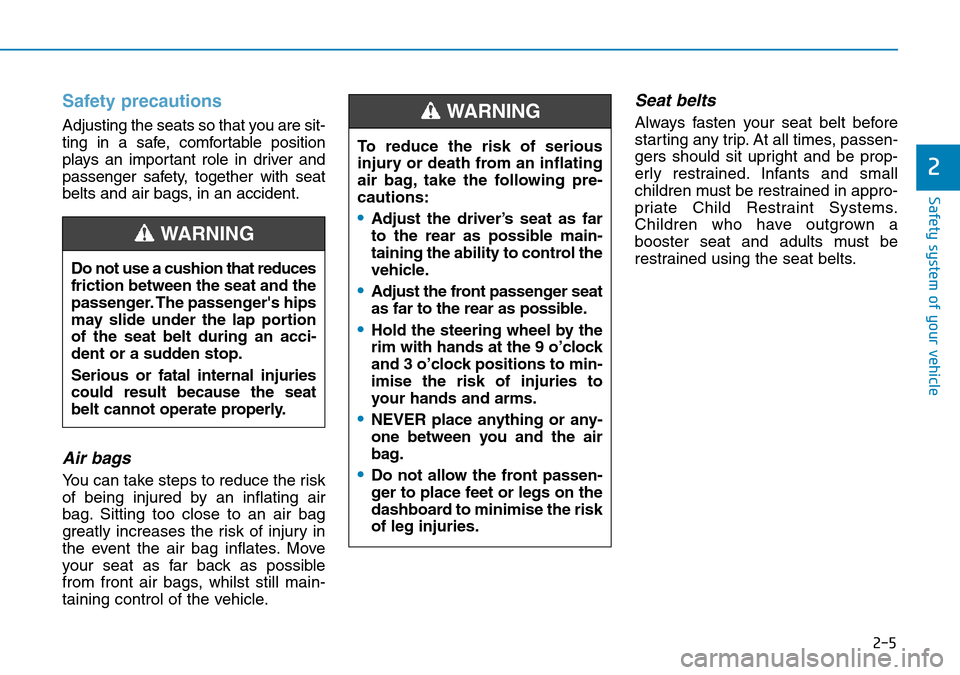
2-5
Safety system of your vehicle
2
Safety precautions
Adjusting the seats so that you are sit-
ting in a safe, comfortable position
plays an important role in driver and
passenger safety, together with seat
belts and air bags, in an accident.
Air bags
You can take steps to reduce the risk
of being injured by an inflating air
bag. Sitting too close to an air bag
greatly increases the risk of injury in
the event the air bag inflates. Move
your seat as far back as possible
from front air bags, whilst still main-
taining control of the vehicle.
Seat belts
Always fasten your seat belt before
starting any trip. At all times, passen-
gers should sit upright and be prop-
erly restrained. Infants and small
children must be restrained in appro-
priate Child Restraint Systems.
Children who have outgrown a
booster seat and adults must be
restrained using the seat belts.
Do not use a cushion that reduces
friction between the seat and the
passenger. The passenger's hips
may slide under the lap portion
of the seat belt during an acci-
dent or a sudden stop.
Serious or fatal internal injuries
could result because the seat
belt cannot operate properly.
WARNING
To reduce the risk of serious
injury or death from an inflating
air bag, take the following pre-
cautions:
•Adjust the driver’s seat as far
to the rear as possible main-
taining the ability to control the
vehicle.
•Adjust the front passenger seat
as far to the rear as possible.
•Hold the steering wheel by the
rim with hands at the 9 o’clock
and 3 o’clock positions to min-
imise the risk of injuries to
your hands and arms.
•NEVER place anything or any-
one between you and the air
bag.
•Do not allow the front passen-
ger to place feet or legs on the
dashboard to minimise the risk
of leg injuries.
WARNING
Page 27 of 682
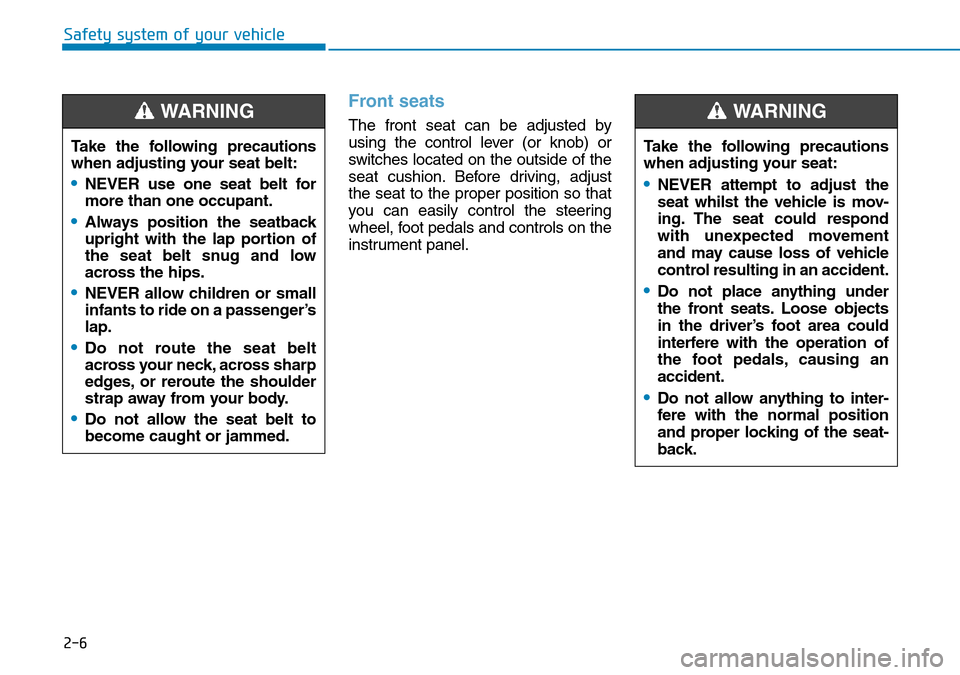
2-6
Front seats
The front seat can be adjusted by
using the control lever (or knob) or
switches located on the outside of the
seat cushion. Before driving, adjust
the seat to the proper position so that
you can easily control the steering
wheel, foot pedals and controls on the
instrument panel.
Safety system of your vehicle
Take the following precautions
when adjusting your seat belt:
•NEVER use one seat belt for
more than one occupant.
•Always position the seatback
upright with the lap portion of
the seat belt snug and low
across the hips.
•NEVER allow children or small
infants to ride on a passenger’s
lap.
•Do not route the seat belt
across your neck, across sharp
edges, or reroute the shoulder
strap away from your body.
•Do not allow the seat belt to
become caught or jammed.
WARNING
Take the following precautions
when adjusting your seat:
•NEVER attempt to adjust the
seat whilst the vehicle is mov-
ing. The seat could respond
with unexpected movement
and may cause loss of vehicle
control resulting in an accident.
•Do not place anything under
the front seats. Loose objects
in the driver’s foot area could
interfere with the operation of
the foot pedals, causing an
accident.
•Do not allow anything to inter-
fere with the normal position
and proper locking of the seat-
back.
WARNING
Page 28 of 682
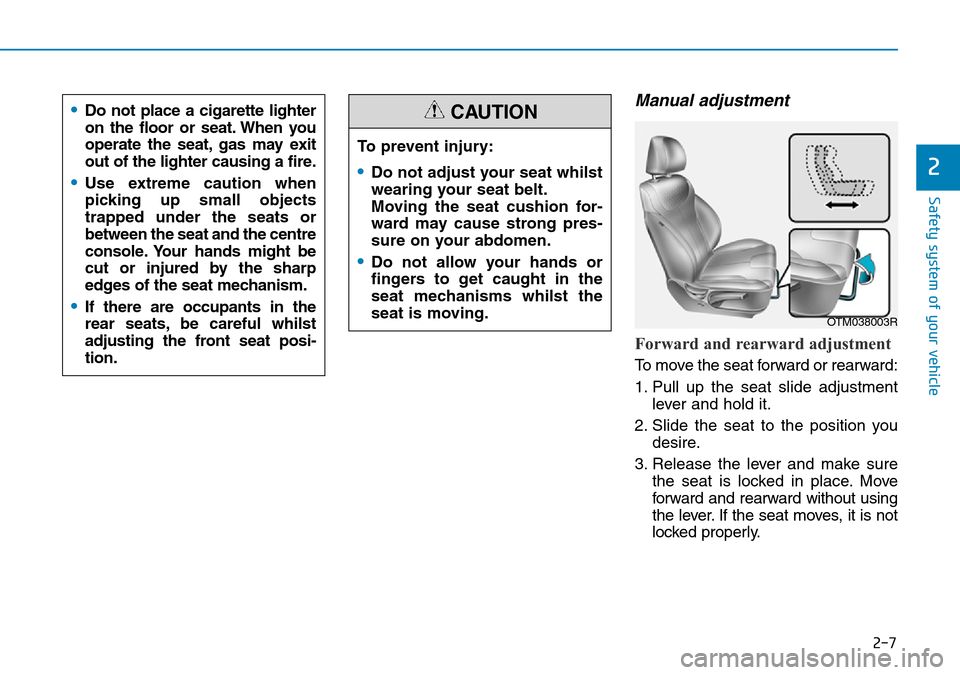
2-7
Safety system of your vehicle
2
Manual adjustment
Forward and rearward adjustment
To move the seat forward or rearward:
1. Pull up the seat slide adjustment
lever and hold it.
2. Slide the seat to the position you
desire.
3. Release the lever and make sure
the seat is locked in place. Move
forward and rearward without using
the lever. If the seat moves, it is not
locked properly. To prevent injury:
•Do not adjust your seat whilst
wearing your seat belt.
Moving the seat cushion for-
ward may cause strong pres-
sure on your abdomen.
•Do not allow your hands or
fingers to get caught in the
seat mechanisms whilst the
seat is moving.
CAUTION•Do not place a cigarette lighter
on the floor or seat. When you
operate the seat, gas may exit
out of the lighter causing a fire.
•Use extreme caution when
picking up small objects
trapped under the seats or
between the seat and the centre
console. Your hands might be
cut or injured by the sharp
edges of the seat mechanism.
•If there are occupants in the
rear seats, be careful whilst
adjusting the front seat posi-
tion.OTM038003R
Page 29 of 682
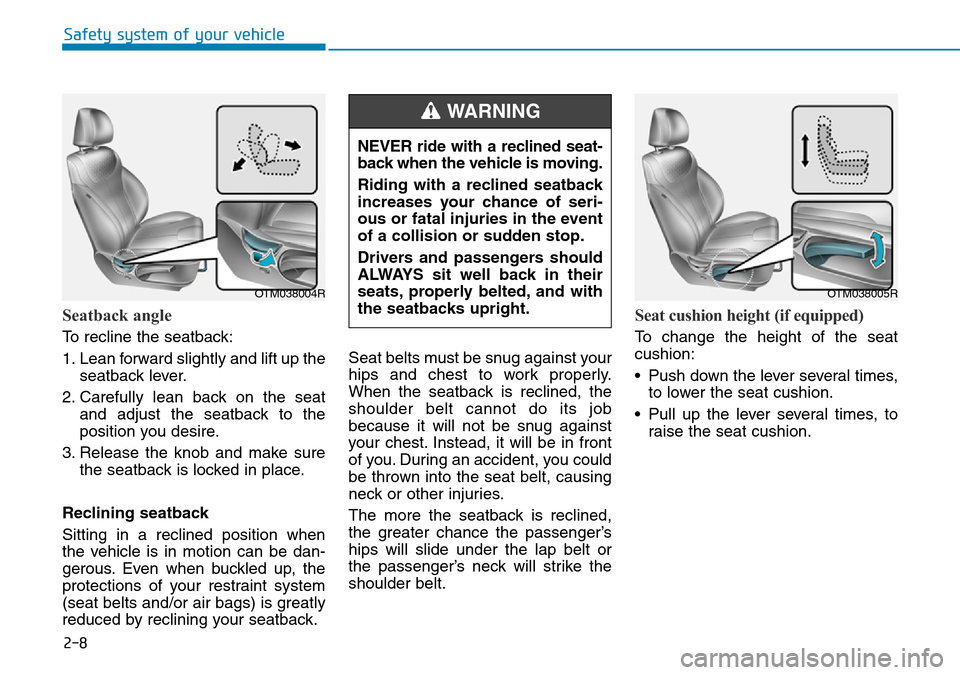
2-8
Safety system of your vehicle
Seatback angle
To recline the seatback:
1. Lean forward slightly and lift up the
seatback lever.
2. Carefully lean back on the seat
and adjust the seatback to the
position you desire.
3. Release the knob and make sure
the seatback is locked in place.
Reclining seatback
Sitting in a reclined position when
the vehicle is in motion can be dan-
gerous. Even when buckled up, the
protections of your restraint system
(seat belts and/or air bags) is greatly
reduced by reclining your seatback.Seat belts must be snug against your
hips and chest to work properly.
When the seatback is reclined, the
shoulder belt cannot do its job
because it will not be snug against
your chest. Instead, it will be in front
of you. During an accident, you could
be thrown into the seat belt, causing
neck or other injuries.
The more the seatback is reclined,
the greater chance the passenger’s
hips will slide under the lap belt or
the passenger’s neck will strike the
shoulder belt.
Seat cushion height (if equipped)
To change the height of the seat
cushion:
• Push down the lever several times,
to lower the seat cushion.
• Pull up the lever several times, to
raise the seat cushion.
OTM038004R
NEVER ride with a reclined seat-
back when the vehicle is moving.
Riding with a reclined seatback
increases your chance of seri-
ous or fatal injuries in the event
of a collision or sudden stop.
Drivers and passengers should
ALWAYS sit well back in their
seats, properly belted, and with
the seatbacks upright.
WARNING
OTM038005R
Page 33 of 682
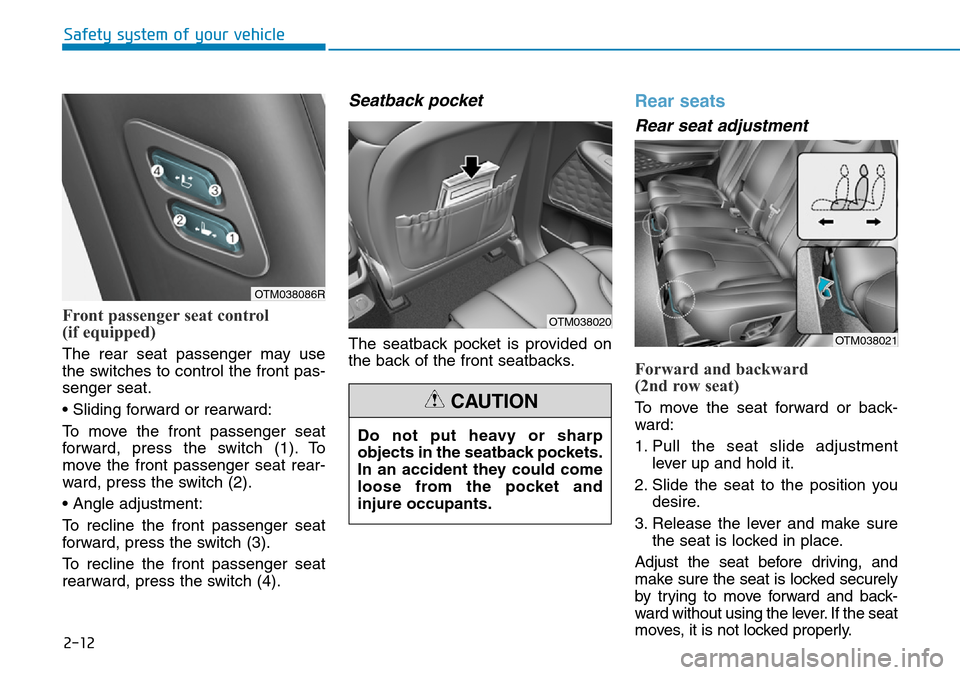
2-12
Safety system of your vehicle
Front passenger seat control
(if equipped)
The rear seat passenger may use
the switches to control the front pas-
senger seat.
• Sliding forward or rearward:
To move the front passenger seat
forward, press the switch (1). To
move the front passenger seat rear-
ward, press the switch (2).
• Angle adjustment:
To recline the front passenger seat
forward, press the switch (3).
To recline the front passenger seat
rearward, press the switch (4).
Seatback pocket
The seatback pocket is provided on
the back of the front seatbacks.
Rear seats
Rear seat adjustment
Forward and backward
(2nd row seat)
To move the seat forward or back-
ward:
1. Pull the seat slide adjustment
lever up and hold it.
2. Slide the seat to the position you
desire.
3. Release the lever and make sure
the seat is locked in place.
Adjust the seat before driving, and
make sure the seat is locked securely
by trying to move forward and back-
ward without using the lever. If the seat
moves, it is not locked properly.
OTM038086R
OTM038020
Do not put heavy or sharp
objects in the seatback pockets.
In an accident they could come
loose from the pocket and
injure occupants.
CAUTION
OTM038021
Page 34 of 682
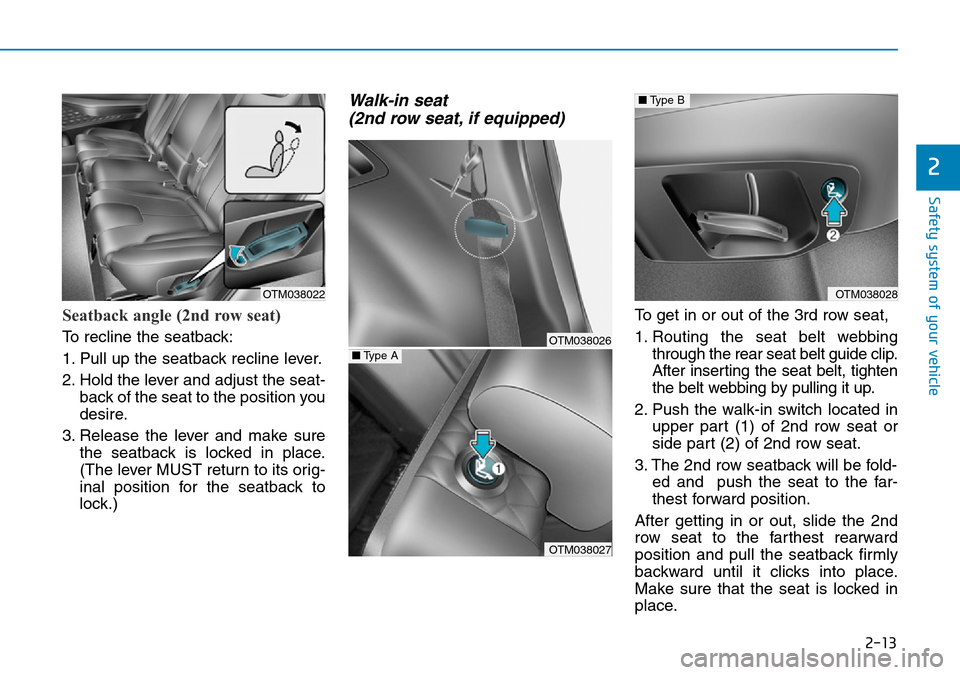
2-13
Safety system of your vehicle
2
Seatback angle (2nd row seat)
To recline the seatback:
1. Pull up the seatback recline lever.
2. Hold the lever and adjust the seat-
back of the seat to the position you
desire.
3. Release the lever and make sure
the seatback is locked in place.
(The lever MUST return to its orig-
inal position for the seatback to
lock.)
Walk-in seat
(2nd row seat, if equipped)
To get in or out of the 3rd row seat,
1. Routing the seat belt webbing
through the rear seat belt guide clip.
After inserting the seat belt, tighten
the belt webbing by pulling it up.
2. Push the walk-in switch located in
upper part (1) of 2nd row seat or
side part (2) of 2nd row seat.
3. The 2nd row seatback will be fold-
ed and push the seat to the far-
thest forward position.
After getting in or out, slide the 2nd
row seat to the farthest rearward
position and pull the seatback firmly
backward until it clicks into place.
Make sure that the seat is locked in
place.
OTM038022
OTM038026
OTM038027
■Type A
OTM038028
■Type B